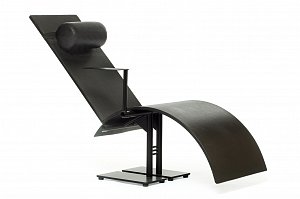Années 80, Mode, design et graphisme
en France revolves around three
important themes that reflect the merging
of ideas and forms specific to the decade:
a new political and cultural era, design
in effervescence, and the “look” of the
80s.
In galleries overlooking the Tuileries
Gardens, the exhibition opens with the
1981 election of François Mitterrand,
announcing a decisive change
in France with a poster featuring the
slogan “La Force Tranquille” (The Quiet
Strength). The poster, commissioned by
Mitterrand and created by advertising
legend, Jacques Séguéla, marked the
dawn of a new era in global visual design
and the arrival of electoral marketing.
The new president’s major projects were
accompanied by a new visual identity, with
graphics created by Grapus for La Villette
and the Louvre, and Jean Widmer for the
Musée d’Orsay.
To promote contemporary creations, the
new president called in five designers
to renovate the private apartments
at L’Élysée, including Marc Held, Ronald
Cecil Sportes, Philippe Starck, Annie Tribel
and Jean-Michel Wilmotte.

Michel Bouvet, Faites de la Musique poster, 1987
© Les Arts Décoratifs / Photo: Christophe Dellière
Jack Lang, the emblematic Minister
of Culture, inaugurated the nationwide
Fête de la Musique in Paris on June 21,
1982, encouraged public recognition of
French fashion with the creation of the
Institut Français de la Mode (IFM)
in 1986, and supported fashion shows
held in the Cour Carrée at the Louvre, as
well as the Oscars of Fashion.
Media and audio-visual production also
experienced an unprecedented boom.
Étienne Robial created the concept
of habillage or audio-visual presentations,
for television stations such as Canal+,
M6 and Channel 7. At the time, the
proliferation of stations led to the golden
years of advertising film thanks to iconic
directors such as Étienne Chatiliez,
Jean-Paul Goude and Jean-Baptiste
Mondino. Written media also underwent
a transformation as Claude Maggiori
redesigned the covers of French daily
‘Libération’ while the ‘art’ of the slogan
flooded all forms of media in existence.
The world of design takes center stage
in the Central Hall of the musée des Arts
décoratifs with an extraordinary blend
of styles that came to life during the
1980s. These include modernist designs
with high-tech accents mixed with neobaroque
and primitive art, exalting the
savoir-faire of the decade.

Martin Szekely, PI Lounge Chair, 1983
Édition Néotù, Carte blanche
of VIA 1982, Fnac 2018
© Les Arts Décoratifs / Photo: Jean Tholance
Steps taken by the Valorisation
de l’Innovation dans l’Ameublement
(VIA), introduced in 1979 by the Minister
of Industry, gave carte blanche to an entire
generation of young creators, among
them, the Totem group, invited to exhibit
at the inauguration of the first showroom.
Contrary to decades past, the artistic
spotlight was not shone on schools
or movements, but rather, on brilliant
individuals such as François Bauchet,
Olivier Gagnère, Sylvain Dubuisson, Jean
Paul Gaultier and Jean-Paul Goude, as well
as Philippe Starck and Martin Szekely.
In the wake of the VIA’s support, avantgarde
spaces dedicated to contemporary
creation were also created, including
Perkal, Néotù, Yves Gastou, En Attendant
les Barbares, Avant-Scène and Gladys
Mougin.

Elizabeth Garouste and Mattia Bonetti, Chaise Mobilier pour la Maison de Couture Christian Lacroix, 1987
© Les Arts Décoratifs / Photo: Jean Tholance © Adagp, Paris, 2022
And
while the State was encouraging creation
in France, private commissions were not
to be outdone. The 1980s were marked
by two iconic private commissions
recreated in the form of period rooms: the
decoration of the Christian Lacroix couture
house by Elizabeth Garouste and Mattia
Bonetti, and the office of auctioneer and
collector, Jean-Claude Binoche by Pucci
de Rossi.

Le Palace Magazine, n°12, 1982
© DR
A tide of celebration and freedom swept
through the 1980s as fashion shows
became spectacular productions,
paving the way for wild nights in now
legendary clubs like Le Palace and
Les Bains Douches.
In those specific clubs, appearance was
everything and eccentricity the rule,
as the Parisian in-crowd danced to the
beats of new wave, rock and hip hop.
Youth diversifies its membership groups,
giving rise to a multiplicity of subcultures
with their own looks.

Élisabeth de Senneville, Two-piece set, 1983
© Les Arts Décoratifs / Photo: Jean Tholance
Fashion was seized by the phenomenon
of revival with looks dating back to ancient
times right through to the 1930s. Thierry
Mugler and Claude Montana drew
inspiration from historic silhouettes while
Jean Paul Gaultier, Vivienne Westwood
and Chantal Thomass parodied the same
looks. Martin Margiela and Rei Kawakubo
for Comme des Garçons took things in
the opposite direction as they attempted
to deconstruct the notion of clothing.
Azzedine Alaïa and Marc Audibet created
designs that hugged the athletic bodies
of supermodels while the ample shapes
of Issey Miyake and Anne-Marie Beretta
were more architectural and became
a genuine medium of expression for
Elisabeth de Senneville and Jean-Charles
de Castelbajac.
Fashion also took hold of the male
wardrobe, as exemplified by Jean Paul
Gaultier’s famous marinière sailor shirt
as mainstream brands like Naf Naf, Kookaï
and Benetton inundated the public space
with their advertising campaigns. At the
same time, from Les Halles district,
agnès b. designs the timeless clothes
of the Parisian woman. The great parade
orchestrated by Jean-Paul Goude
celebrating the bicentenary of the French
Revolution in 1989 brought the decade
to a dazzling close.

Maison Martin Margiela, Ankle boots tabi, 1989
© Les Arts Décoratifs / Photo: Christophe Dellière
Retracing the highlights of a decade
that rewrote the rules, the musée des
Arts décoratifs also pays tribute to
its own story: the Musée de l’Affiche
et de la Publicité, founded in 1982, and
the Musée des Arts de la Mode, founded
in 1986, now part of the institution.
Années 80, Mode, design et graphisme
en France reminds us how the 80s
represented a joyful clash of styles and
how that memorable decade filled the
worlds of fashion, design and graphic arts
with a spontaneity and freedom.